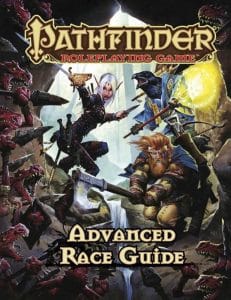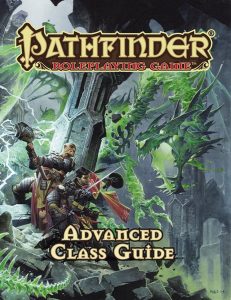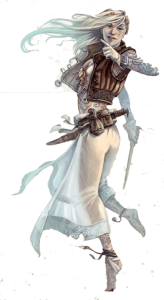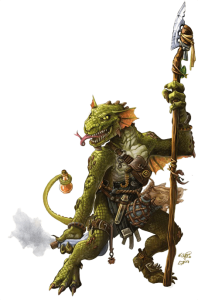At the heart of a Pathfinder character is the character’s class and race. These are two of the initial things you decide upon when you start creating the character.
A Pathfinder character’s class and race determine many of your starting abilities and what abilities you may gain as you increase in power. The core races include the standard fantasy races such as humans, elves, and dwarves, while the core classes include fantasy tropes like wizards, fighters, druids.
But not surprisingly, there’s a lot more out there besides what’s in the Core Rulebook.
Most of the books I’ve covered in my previous articles in this series have included new classes, like the gunslinger in Ultimate Combat or the magus in Ultimate Magic, along with new options for all classes, such as archetypes. However, you may have noticed a lack of options mentioned for races.
The Advanced Player’s Guide has some options to swap out racial abilities for alternative abilities, along with additional favoured class options. However, for the most part, the hardcover rulebooks in the Pathfinder Roleplaying Game line don’t add much in the way of new options for races.
The notable exception to this, however, is the Advanced Race Guide.
Diversifying Your Pathfinder Character with the Advanced Race Guide
 The Advanced Race Guide expands the information on races in the game. For each race, it provides some background information along with the standard racial traits. It also contains alternate racial traits (abilities that you can swap out standard abilities to gain) for each race, along with numerous other options, such as race-specific feats, archetypes, spells, equipment, and so on.
The Advanced Race Guide expands the information on races in the game. For each race, it provides some background information along with the standard racial traits. It also contains alternate racial traits (abilities that you can swap out standard abilities to gain) for each race, along with numerous other options, such as race-specific feats, archetypes, spells, equipment, and so on.
The Advanced Race Guide contains a significant amount of new material for the core races, but also adds options for numerous other races. This gives you the opportunity to play aasimars and catfolk, and more unusual races like kitsune, samsarans, or strip (Here are 7 of our favorites).
You can also play many races that are more generally thought of as monstrous or evil races, such as orcs, goblins, and drow.
The final chapter of the Pathfinder Advanced Race Guide is a system of rules for creating new races. The system assigns points to various different kinds of abilities that you can give races. The total number of ability points your new race has allows you to see how the race compares to other existing races. This can help you avoid creating races that are too powerful or not powerful enough.
Giving You Pathfinder Character a Job to Do with the Advanced Class Guide
 The Advanced Class Guide is similar in some ways to the Advanced Race Guide, except that its focus is on classes. Of course, as I said, classes have received a lot of support in other books, so it doesn’t spend a great deal of time on the core classes the way the Advanced Race Guide does with the core races.
The Advanced Class Guide is similar in some ways to the Advanced Race Guide, except that its focus is on classes. Of course, as I said, classes have received a lot of support in other books, so it doesn’t spend a great deal of time on the core classes the way the Advanced Race Guide does with the core races.
Instead, the Advanced Class Guide introduces ten new classes to the game.
All of these classes are “hybrid” classes. Each combines aspects of two existing classes to create a brand new class. For example, the hunter is a combination of ranger and druid. It gains an animal companion like both its parent classes, along with spellcasting and other abilities.
The skald is a hybrid of barbarian and bard. A skald can grant the barbarian’s rage ability to other people through music or other kinds of performance.
As well as these new classes, the Advanced Class Guide also contains new archetypes for all classes, along with the usual new feats, spells, and equipment. Most of the options in the book focus on providing various classes with some of the abilities of other classes. The mutation warrior fighter archetype, for example, provides fighters with a couple of alchemist abilities.
Finally, the Advanced Class Guide contains a chapter on designing your own classes. However, this is not a full rules system like the race builder in the Advanced Race Class. Instead, it is simply advice, since creating classes is more art than science.
The Pathfinder Advanced Race Guide and Advanced Class Guide: Final Thoughts
 Across these two books and other rulebooks, there are a lot of choices available for class and race. The Advanced Race Guide covers 37 races (not including sample races made with the race building rules), and there are a similar number of classes scattered across the various books.
Across these two books and other rulebooks, there are a lot of choices available for class and race. The Advanced Race Guide covers 37 races (not including sample races made with the race building rules), and there are a similar number of classes scattered across the various books.
The large number can be inspiring, but it can also be intimidating. Why choose the hybrid arcanist class when you’re still not sure about the difference between a sorcerer and a wizard (the arcanist’s parent classes)?
It’s important to know what classes and races are included in your game, as not every game will include them all. The campaign setting or style of game your gamemaster is planning may preclude some of them.
For example, the gunslinger is a class that may not be appropriate for every game. The swashbuckler is a hybrid of fighter and gunslinger, so can you play a swashbuckler if your game doesn’t include gunslingers? The swashbuckler doesn’t automatically gain gun-related abilities. It simply uses similar mechanics to the gunslinger. As such, it may or may not work in a game where there are no gunslingers.
If you are a player in a game, you should discuss with your gamemaster if you want to use classes, races, or any other ability from a book other than the Core Rulebook. If you are the gamemaster, the final decision of what to include probably comes down to you, but you should still be willing to listen to what your players are interested in.
 Deciding which options to include in a game depends a great deal on your group’s needs and desires, but I can offer a few general guidelines. There can be a temptation to include everything. If it’s printed in a book, then it’s in. This isn’t necessarily a bad way to play—indeed, if it works for your group, then that’s what you should do—but it can be overwhelming to throw in everything at once if you’re new to the game.
Deciding which options to include in a game depends a great deal on your group’s needs and desires, but I can offer a few general guidelines. There can be a temptation to include everything. If it’s printed in a book, then it’s in. This isn’t necessarily a bad way to play—indeed, if it works for your group, then that’s what you should do—but it can be overwhelming to throw in everything at once if you’re new to the game.
My advice would be to take it slow. Once you’re comfortable with the core rules, pick one or two books to add. Once you’re comfortable with them, you can start adding more things. In time, you’ll discover what works for you and your fellow group members.
Of course, the most important rule of all is: have fun. If a class, race, or other option is making your game better, keep it. If it’s making the game worse, get rid of it. It’s as simple as that.
Next time, we’ll move to looking more at the gamemaster’s side of the game and the books available to help you run the game.
If you are new to the Pathfinder RPG, get the Core Rulebook first. Then pick up the Advanced Race Guide and Advanced Class Guide.

